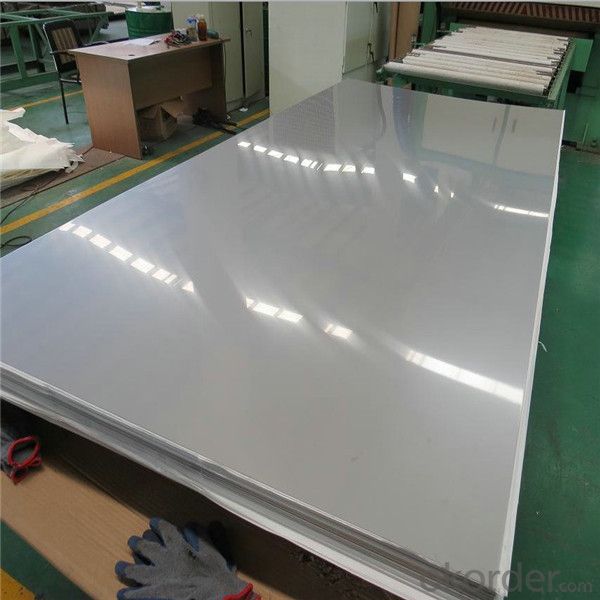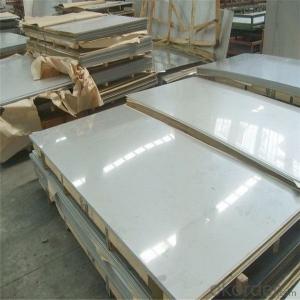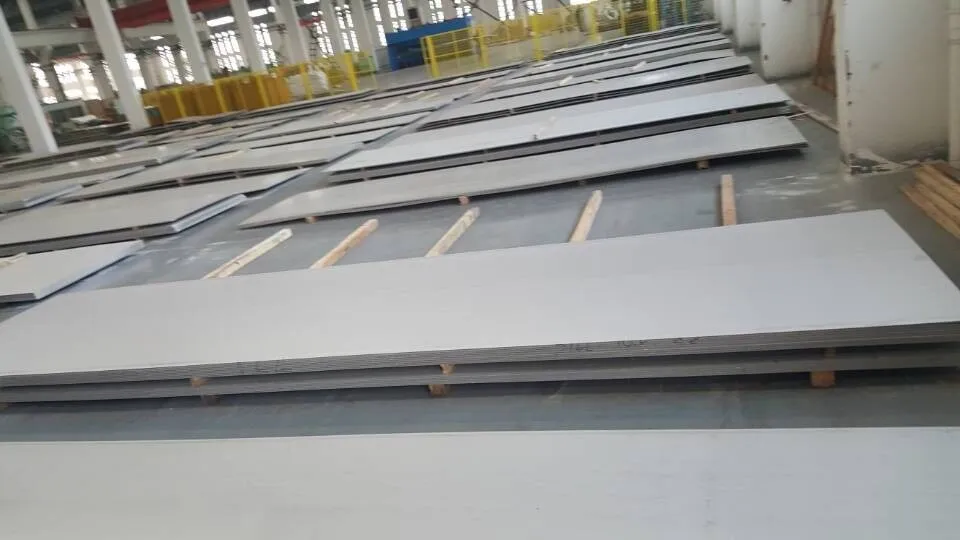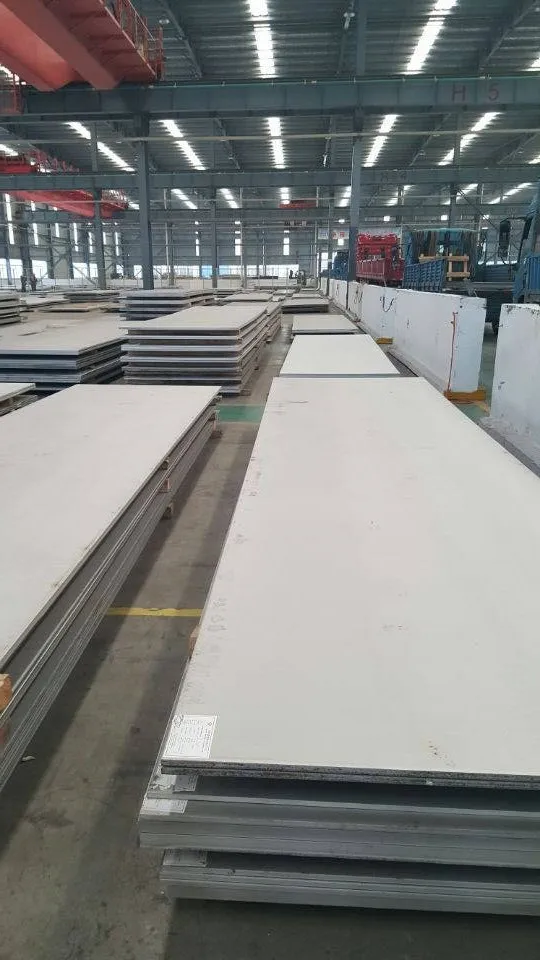Stainless Steel Plate 2205 2507 2520 duplex
- Loading Port:
- Shanghai
- Payment Terms:
- TT OR LC
- Min Order Qty:
- 4 m.t.
- Supply Capability:
- 20000 m.t./month
OKorder Service Pledge
OKorder Financial Service
You Might Also Like
Item specifice
2205 2507 2520 duplex stainless steel plate
We are a professional manufacturer of stainless steel sheet. According to ASTM, JIS and AISI,GB, standards, Jaway steel enhances effectiveness and of quality control from selecting the raw materials, cutting, slitting, shearing, surface treatment, packing, exporting of the existing products.
Product Description
Product Name | Mill test certificate 2205 2507 2520 duplex stainless steel plate |
Material | stainless steel |
Color | natural color or as require |
Standard | AISI ASTM JIS SUS and GB |
Grade | 201/304/304L/321/316/316L/309/309S/310S/904L/2205/2507/2520 |
Packing | Seaworthy wooden pallet or according to client's requirement |
Thickness tolerance | +/- 0.25% |
Delivery time | Within 7-15days after getting your deposit. |
Advantages | Strong corrosion and decorative effect |
Mill | TISCO, ZPSS, BAO STEEL, POSCO ,LZ ,etc. |
Products Show
These are the normal items, for the special requirements,we can also meet.
Surface finish | Characteristics and application |
NO.2B | The surface brightness and flatness of no2B is better than no2D. then through a special surface treatment to improve its mechanical properties,No2B could nearly satisfy comprehensive uses. |
NO.3 | Polished with abrasive belt of git#100-#200, have better brightness with discontinuous coarse stria, used as inner and external ornaments for building, electrical appliances and kitchen utensils etc. |
NO.4 | Polished with abrasive belt of grit #150-#180,have better brightness with discontinuous coarse stria,but thinner than No3, are used as bathtub buildings inner and external ornaments electrical appliances kitchen utensils and food processing equipment etc. |
HL | Polished with abrasive belt of grit #150-#320 on the NO.4 finish and has continuous streaks, mainly used as buildings ornaments elevators,door of building, frontal plate etc. |
BA | Cold rolled, bright annealed and skin-passed, the product have excellent brightness and good reflexivity like mirror,kitchen apparatus,ornament etc. |
8K | The product have excellent brightness and prefer reflexivity can to be the mirror. |


Our Advantages
• All products are made of high-quality imported raw materials.
• Our products are certified by ISO9001:2008 authentication quality systems.
• we are nominated as the AAA enterprise by Jiangsu government.
• Quick Response to Your Enquiry.
- Q:What are the different types of stainless steel sheet finishes for pharmaceutical applications?
- There are several different types of stainless steel sheet finishes that are commonly used in pharmaceutical applications. These finishes are designed to provide specific characteristics and properties to meet the requirements of pharmaceutical manufacturing processes. 1. No.1 Finish: This is the most basic stainless steel sheet finish, characterized by a dull, rough surface. It is typically used for applications where appearance is not a concern, but corrosion resistance and durability are important. 2. No.2D Finish: Also known as a "dull" finish, this type of finish has a slightly smoother surface than No.1 finish. It is achieved by cold rolling the stainless steel sheet and then annealing it. No.2D finish is commonly used in pharmaceutical applications where a smooth surface is required for easy cleaning and maintenance. 3. No.2B Finish: This is one of the most popular finishes for stainless steel sheets in pharmaceutical applications. It has a smooth, reflective surface that is achieved by cold rolling, annealing, and then pickling or passivating the stainless steel sheet. No.2B finish provides excellent corrosion resistance and is easy to clean, making it suitable for pharmaceutical environments. 4. No.3 Finish: This type of finish has a semi-reflective surface with a slightly coarse texture. It is achieved by using a fine abrasive material to polish the stainless steel sheet. No.3 finish is commonly used in pharmaceutical applications where a decorative appearance is desired, while still maintaining good corrosion resistance. 5. No.4 Finish: This is a popular finish for stainless steel sheets in pharmaceutical applications that require both a decorative appearance and good corrosion resistance. It has a brushed appearance, achieved by using a fine abrasive material in a linear motion. No.4 finish also provides a smooth surface that is easy to clean. 6. No.6 Finish: This type of finish is achieved by using a fine abrasive material in a circular motion, resulting in a satin-like appearance. No.6 finish is commonly used in pharmaceutical applications where a high-quality aesthetic finish is desired, such as for equipment that is visible to patients or visitors. In conclusion, the different types of stainless steel sheet finishes for pharmaceutical applications offer a range of characteristics and properties to meet the specific needs of the industry. Whether it is for corrosion resistance, easy cleaning, or a decorative appearance, there is a suitable finish available for every pharmaceutical application.
- Q:Are stainless steel sheets suitable for high-temperature environments?
- Stainless steel sheets are generally considered suitable for high-temperature environments. The reason for this is that stainless steel possesses exceptional heat resistance and retains its structural integrity even at elevated temperatures. The maximum temperature resistance of stainless steel depends on the specific grade used. Austenitic stainless steel varieties, such as 304 and 316, can endure temperatures as high as 870°C (1600°F). In contrast, ferritic stainless steel, like 430, has a slightly lower maximum temperature limit of approximately 760°C (1400°F). Moreover, the corrosion resistance, durability, and ease of maintenance of stainless steel sheets make them a popular choice for high-temperature applications.
- Q:Can stainless steel sheets be used for wall paneling?
- Yes, stainless steel sheets can be used for wall paneling. They are durable, resistant to corrosion, and provide a sleek and modern aesthetic to any space. They are commonly used in kitchens, bathrooms, and commercial settings as they are easy to clean and maintain.
- Q:What are the applications of stainless steel sheets in the construction industry?
- Stainless steel sheets have various applications in the construction industry due to their unique properties. They are often used for cladding buildings, roofing, and wall systems, providing durability and resistance to corrosion. Additionally, stainless steel sheets are used for structural components such as beams, columns, and reinforcement bars, ensuring strength and longevity in construction projects. They are also utilized in decorative applications, such as handrails, facades, and interior design elements, enhancing the aesthetic appeal of buildings. Overall, stainless steel sheets play a crucial role in the construction industry by offering both functional and aesthetic benefits.
- Q:What is the maximum thickness of a stainless steel sheet?
- The maximum thickness of a stainless steel sheet can vary depending on the specific type and grade of stainless steel being used. However, stainless steel sheets are commonly available in thicknesses ranging from 0.4mm to 6mm or even thicker for certain industrial applications.
- Q:How do stainless steel sheets compare to other types of metal sheets?
- Stainless steel sheets have several advantages over other types of metal sheets. They are highly resistant to corrosion, making them suitable for various applications in industries such as automotive, construction, and food processing. Stainless steel sheets also offer exceptional strength and durability, ensuring long-lasting performance. Additionally, they have an attractive appearance, making them popular for aesthetic purposes. While stainless steel sheets may be slightly more expensive than other metal sheets, their numerous benefits make them a worthwhile investment.
- Q:Can stainless steel sheets be used for beer tanks?
- Yes, stainless steel sheets can be used for beer tanks. Stainless steel is a commonly used material for beer tanks due to its durability, corrosion resistance, and ability to maintain the quality and taste of the beer. It provides a hygienic and easy-to-clean surface, making it ideal for use in the brewing industry.
- Q:What's the difference between stainless steel 302 and 304?
- 304 stainless steel is a widely used chromium - nickel stainless steel, as a widely used steel, corrosion resistance, good heat resistance, low temperature strength and mechanical properties; punching, bending and other thermal processing, non hardening heat treatment (use temperature of -196 to 800 DEG C). 302 stainless steel the carbon is relatively high (302 C = 0.15%; 304 C is less than or equal to 0.08%) and better strength. The other indicators are basically the same as those of 304.
- Q:Are stainless steel sheets suitable for architectural mesh applications?
- Yes, stainless steel sheets are highly suitable for architectural mesh applications due to their durability, resistance to corrosion, and versatility in design. They provide excellent strength and can be easily manipulated into various shapes and patterns, making them ideal for creating aesthetically pleasing and functional architectural elements such as facades, partitions, and decorative screens.
- Q:What's the drill for stainless steel?
- The cutting fluid is made of concentrated emulsions. Commonly used stainless steel drills are: high cobalt bit (M35 bit, M42 bit), in which the M42 bit is the most cost-effective, and carbide drills are also available.
1. Manufacturer Overview |
|
|---|---|
| Location | |
| Year Established | |
| Annual Output Value | |
| Main Markets | |
| Company Certifications | |
2. Manufacturer Certificates |
|
|---|---|
| a) Certification Name | |
| Range | |
| Reference | |
| Validity Period | |
3. Manufacturer Capability |
|
|---|---|
| a)Trade Capacity | |
| Nearest Port | |
| Export Percentage | |
| No.of Employees in Trade Department | |
| Language Spoken: | |
| b)Factory Information | |
| Factory Size: | |
| No. of Production Lines | |
| Contract Manufacturing | |
| Product Price Range | |
Send your message to us
Stainless Steel Plate 2205 2507 2520 duplex
- Loading Port:
- Shanghai
- Payment Terms:
- TT OR LC
- Min Order Qty:
- 4 m.t.
- Supply Capability:
- 20000 m.t./month
OKorder Service Pledge
OKorder Financial Service
Similar products
New products
Hot products
Related keywords

































